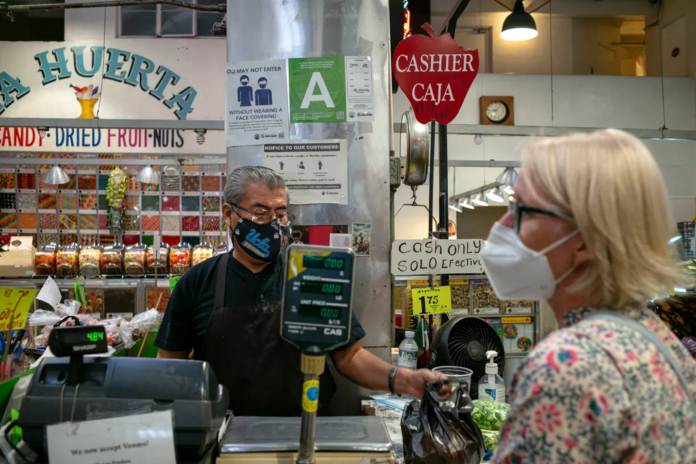
While COVID-19’s omicron wave appears to have crested, it leaves in its wake sick nurses and burnt out bus drivers,short-staffed hospitals and canceled surgeries, school districts scrambling for substitute teachers and grocery store cashiers forced to choose between their health and their finances.
Other countries met this variant with fresh lockdowns. Other states authorized state bureaucrats to moonlight as teachers. In New York City and Washington D.C., businesses are now required to check the vaccine status of their customers.
Would any of that have kept California workers safe, curtailed the worst of the spread and avoided cascading labor shortages? And what can lawmakers do now to prepare for the future of COVID — be it the next deadly variant or the low-level simmer of a pathogen gone endemic?
Five waves and nearly two years into the COVID-19 pandemic, this virus still doesn’t brook any easy solutions.
Did it have to be this way?
If public opinion were no object, tighter mask mandates and increased vaccinations after the delta wave in the late summer would have blunted some of omicron’s impact, said Dr. John Swartzberg, a clinical professor emeritus of infectious diseases and vaccinology at UC Berkeley. But the variant’s transmissibility is so formidable that even with those measures, omicron still would have been a problem, he said.
“Frankly, I think that California did a reasonable job trying to balance protecting people from the virus and allowing people’s lives to function in a more normal fashion,” Swartzberg said.
Broad shutdowns, he said, probably would not have made a manifest difference in how many people got sick, a sentiment shared by other public health experts contacted for this story.
While other states and countries responded differently to omicron’s spread, case counts suggest that policy differences didn’t make a drastic impact on the course of this surge, said Jeffrey Clemens, a health economist and associate professor at UC San Diego.
“There probably weren’t many steps that governments could have taken in real time in an effort to significantly blunt the wave,” said Clemens.
It may take a couple months, to know whether local or state policies made a difference in how many people got severly ill or died from this surge.
If the state deserves criticism for its strategy leading up to the current crisis, it was for focusing too narrowly on vaccine promotion, said Peter Chin-Hong, an infectious disease physician at UC San Francisco.
“Putting all the eggs in the vaccine basket” meant there was less focus on stockpiling masks, tests and new treatments like monoclonal antibodies that have rendered COVID much less of a threat for the vast majority of vaccinated patients, he said. “I think we could have been more proactive as a state. We have the resources, we have the brainpower, we have the wherewithal.”
Another cohort of Bay Area-based medical professionals and researchers say that if there’s a lesson to be learned from the most recent COVID surge, it’s that state public health officials have been too slow to recognize the actual, much-diminished threat that the virus poses to most people in 2022.
Last week four doctors associated with UC San Francisco wrote a controversial letter drawing a very different lesson from the state’s experience weathering omicron: California needs to eliminate masking and testing requirements at schools as soon as the current surge has subsided.
Whether the state could have done more to limit the spread of omicron is the wrong question to ask, said emergency medicine professor Jeanne Noble, who co-authored the letter. Instead public health policy should strive to “get that very small sliver of our population maximally protected and not in this more clunky way of restricting the lives and social norms of the population at large.”
No lockdowns in sight
Even as many Californians were still learning how to pronounce “omicron” in early December, Newsom had already ruled out the possibility of another lockdown. With so many state residents vaccinated, such drastic social distancing measures were no longer demanded by the science, he said at the time. Nor, presumably, would they have been tolerated by much of the COVID-weary public.
California’s Democratic governor wasn’t the only governor to make that calculation. Even as hospitals ran out of beds, schools ran out of unexposed teachers and graphs ran out of vertical space to accommodate the stratospheric case numbers, not a single state imposed new lockdown measures.
That was a sharp contrast from two years prior. Back then, blue state governors in particular were quick to shutter businesses and schools. This time the prevailing focus has been to keep things up and running. In Michigan,Oklahoma, and North Carolina, governors handed down emergency orders deploying state workers and school district administrative staff into classrooms in order to keep schools open. New Mexico’s governor, Lujan Grisham, went a step further and became a substitute herself.
Other states have tried to address omicron-induced worker shortages with financial incentives. Lawmakers in Kentucky are considering whether to offer loan forgiveness to nurses and social workers.
Earlier this month, U.S. Health and Human Services Secretary Xavier Becerra said that the department would be spending $103 million on programs that address health care worker “burnout,” $8.7 million of which will go to three hospitals and one nonprofit in California.
Newsom’s omicron response
Since omicron arrived in California, the Newsom administration has tried some version of all of these approaches. Earlier this month, the governor issued an executive order making it easier for schools to hire substitute teachers. In the budget proposal the governor submitted to the Legislature earlier this month, he requested that the state continue to waive credentialing fees for new teachers and that $3 million be set aside to “research health care shortages.”
In November, prior to the arrival of omicron, the administration finalized a request to Legislature to set aside an extra $1.4 billion in emergency COVID spending above and beyond the state budget passed last year. Of that total ask, $478 million would be used to to hire more nurses and clinicians to relieve short-staffed hospitals. This week they bumped up that total request to $2.3 billion, with another $8 million set aside for “surge” staffing.
For all that extra spending, the administration appears optimistic that the wave will soon recede and that a new one isn’t likely to follow. Tucked into his budget proposal is the assumption that Californians will be back to work at “pre-pandemic labor force levels” by the late summer or early fall of 2022.
On Tuesday, Newsom and legislative leaders announced what is certainly the most dramatic response to workplace disruptions since the beginning of the current wave: an agreement to revive a paid COVID sick leave policy for employees at medium and large-sized companies.
Under the terms of the deal, which isn’t likely to become law for at least a week, workers could get up to two weeks of paid time off to recuperate or help a family member recover from COVID. Businesses would be compensated in part with additional tax credits. Workers would be able to apply for compensation retroactively for any work missed after January 1.
The new agreement was heralded by labor unions and anti-poverty groups, while getting a tepid response from the state’s business lobby.
“Some of the workforce shortages that we’re seeing right now are being caused primarily because folks don’t have the ability to isolate, and to do so with some economic security,” said Eduardo Martinez, legislative director for California Labor Federation.
What comes next?
The coronavirus has been difficult to predict, said Swartzberg, the infectious disease expert at UC Berkeley. If another variant comes along that completely evades the protections recent infection and vaccinations offer, he said, “we’re going to be still riding the roller coaster.”
But that’s unlikely, he thinks. With so many Californians vaccinated or recently infected — or both — we could be headed for a world in early March where case levels remain relatively constant and people can essentially live their normal lives, with sound judgment and a mask in their back pocket, said Swartzberg.
Ensuring that employers and workers have easy access to testing would give business owners a degree of certainty going forward, said Mark Herbert, chief strategy officer for Small Business Majority, a policy advocacy organization. He pointed to California’s effort to distribute tests to child care providers in late January as one step in that direction. The Newsom’s administration’s request this week for additional funds to respond to omicron also included $386 million for testing.
Shoring up the child care system — which is facing its own acute staffing problems, layered on top of a longer-term shortage of providers — could help address the worker shortages elsewhere by giving parents more reliable access to child care. Measures put in place earlier in the pandemic, including fee waivers for low-income families, and paying providers who offer state-subsidized care based on enrollment rather than attendance, are set to expire this summer, said Kristin Schumacher, a senior policy analyst at the California Budget and Policy Center.
The governor’s budget proposal includes a $5.8 billion investment in child care programs, used in part to add tens of thousands subsidized child care slots.
The Newsom administration is thinking about the next phase of the pandemic, too. At a testing site in Paramount earlier this month, the governor acknowledged that his administration is now preparing for a new “endemic phase of this reality and how we live with future variants,” and said there would be more details in the coming weeks. Entering an “endemic” phase would mean the virus’s presence is relatively constant, and not causing unpredictable disruptions.
If there’s a period of quiet after omicron, public health experts warn that we can’t squander it.
“We need to, of course, be using COVID as preparation,” said Chin-Hong. “Not just for the next variant, but for the next pandemic.”
SoCoNews is partnering with CalMatters to provide a wider variety of news that gives our readers national and regional context for issues facing our local communities.







